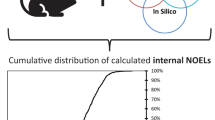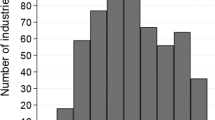Abstract
Serial measurements of serum lipid 2,3,7,8-tetrachlorodibenzo-p-dioxin (TCDD) concentrations in 36 adults from Seveso, Italy, and three patients from Vienna, Austria, with initial serum lipid TCDD concentrations ranging from 130 to 144,000 ppt, were modeled using a modified version of a previously published toxicokinetic model for the distribution and elimination of dioxins. The original model structure accounted for a concentration-dependent increase in overall elimination rate for TCDD due to nonlinear distribution of TCDD to the liver (secondary to induction of the binding protein CYP1A2), from which elimination takes place via a first-order process. The original model structure was modified to include elimination due to lipid partitioning of TCDD from circulation into the large intestine, based on published human data. We optimized the fit of the modified model to the data by varying the hepatic elimination rate parameter for each of the 39 people. The model fits indicate that there is significant interindividual variability of TCDD elimination efficiency in humans and also demonstrate faster elimination in men compared to women, and in younger vs. older persons. The data and model results indicate that, for males, the mean apparent half-life for TCDD (as reflected in changes in predicted serum lipid TCDD level) ranges from less than 3 years at serum lipid levels above 10,000 ppt to over 10 years at serum lipid levels below 50 ppt. Application of the model to serum sampling data from the cohort of US herbicide-manufacturing workers assembled by the National Institute of Occupational Safety and Health (NIOSH) indicates that previous estimates of peak serum lipid TCDD concentrations in dioxin-exposed manufacturing workers, based on first-order back-extrapolations with half-lives of 7–9 years, may have underestimated the maximum concentrations in these workers and other occupational cohorts by several-fold to an order of magnitude or more. Such dose estimates, based on a single sampling point decades after last exposure, are highly variable and dependent on a variety of assumptions and factors that cannot be fully determined, including interindividual variations in elimination efficiency. Dose estimates for these cohorts should be re-evaluated in light of the demonstration of concentration-dependent elimination kinetics for TCDD, and the large degree of uncertainty in back-calculated dose estimates should be explicitly incorporated in quantitative estimates of TCDD's carcinogenic potency based on such data.
This is a preview of subscription content, access via your institution
Access options
Subscribe to this journal
Receive 6 print issues and online access
$259.00 per year
only $43.17 per issue
Buy this article
- Purchase on Springer Link
- Instant access to full article PDF
Prices may be subject to local taxes which are calculated during checkout










Similar content being viewed by others
References
Abraham K., Geusau A., Tosun Y., Helge H., Bauer S., and Brockmoller J. Severe 2,3,7,8-tetrachlorodibenzo-p-dioxin (TCDD) intoxication: insights into the measurement of hepatic cytochrome P450 1A2 induction. Clin Pharmacol Ther 2002: 72(2): 163–174.
Aylward L.L., and Hays S.M. Temporal trends in human TCDD body burden: decreases over three decades and implications for exposure levels. J Expos Anal Environ Epidemiol 2002: 12: 319–328.
Aylward L.L., Hays S.M., Karch N.J., and Paustenbach D.J. Relative susceptibility of animals and humans to the cancer hazard posed by 2,3,7,8-tetrachlorodibenzo-p-dioxin using internal measures of dose. Environ Sci Technol 1996: 30(12): 3534–3543.
Becher H., Steindorf K., and Flesch-Janys D. Quantitative cancer risk assessment for dioxins using an occupational cohort. Environ Health Perspect 1998: 106(2): 663–670.
Carrier G., Brunet R.C., and Brodeur J. Modeling of the toxicokinetics of polychlorinated dibenzo-p-dioxins and dibenzofurans in mammalians, including humans. I. Nonlinear distribution of PCDD/PCDF body burden between liver and adipose tissues. Toxicol Appl Pharmacol 1995a: 131(2): 253–266.
Carrier G., Brunet R.C., and Brodeur J. Modeling of the toxicokinetics of polychlorinated dibenzo-p-dioxins and dibenzofurans in mammalians, including humans. II. Kinetics of absorption and disposition of PCDDs/PCDFs. Toxicol Appl Pharmacol 1995b: 131(2): 267–276.
Carrier G., Brunet R.C., Mocarelli P., Brambilla G., Gerthoux P.M., Needham L.L., and Patterson D.G. TCDD kinetics in Seveso patients. Organohalogen Compounds 1999: 42: 159–164.
Crump K.S., Canady R., and Kogevinas M. Meta-analysis of dioxin cancer dose response for three occupational cohorts. Environ Health Perspect 2003: 111(5): 681–687.
Deurenberg P., Andreoli A., Borg P., Kukkonen-Harjula K., de Lorenzo A., van Marken Lichtenbelt W.D., Testolin G., Vigano R., and Vollaard N. The validity of predicted body fat percentage from body mass index and from impedance in samples of five European populations. Eur J Clin Nutr 2001: 55(11): 973–979.
Deurenberg P., Weststrate J.A., and Seidell J.C. Body mass index as a measure of body fatness: age- and sex-specific prediction formulas. Br J Nutr 1991: 65(2): 105–114.
Fingerhut M.A., Halperin W.E., Marlow D.A., Piacitelli L.A., Honchar P.A., Sweeney M.H., Greife A.L., Dill P.A., Steenland K., and Suruda A.J. Cancer mortality in workers exposed to 2,3,7,8-tetrachlorodibenzo-p-dioxin (see comments). N Engl J Med 1991: 324(4): 212–218.
Flesch-Janys D., Becher H., Gurn P., Jung D., Konietzko J., Manz A., and Papke O. Elimination of polychlorinated dibenzo-p-dioxins and dibenzofurans in occupationally exposed persons. J Toxicol Environ Health 1996: 47(4): 363–378.
Flesch-Janys D., Steindorf K., Gurn P., and Becher H. Estimation of the cumulated exposure to polychlorinated dibenzo-p-dioxins/furans and standardized mortality ratio analysis of cancer mortality by dose in an occupationally exposed cohort. Environ Health Perspect 1998: 106(Suppl 2): 655–662.
Geusau A., Schmaldienst S., Derfler K., Papke O., and Abraham K. Severe 2,3,7,8-tetrachlorodibenzo-p-dioxin (TCDD) intoxication: kinetics and trials to enhance elimination in two patients. Arch Toxicol 2002: 76(5–6): 316–325.
Geusau A., Tschachler E., Meixner M., Sandermann S., Papke O., Wolf C., Valic E., Stingl G., and McLachlan M. Olestra increases faecal excretion of 2,3,7,8-tetrachlorodibenzo-p-dioxin. Lancet 1999: 354(9186): 1266–1267.
Hu K., and Bunce N.J. Metabolism of polychlorinated dibenzo-p-dioxins and related dioxin-like compounds. J Toxicol Environ Health Part B 1999: 2: 183–210.
Jackson J.A., Birnbaum L.S., and Diliberto J.J. Effects of age, sex, and pharmacologic agents on the biliary elimination of 2,3,7,8-tetrachlorodibenzo-p-dioxin (TCDD) in F344 rats. Drug Metab Dispos 1998: 26(7): 714–719.
Kitamura K., Nagahashi M., Sunaga M., Watanabe S., and Nagao M. Balance of intake and excretion of 20 congeners of polychlorinated dibenzo-p-dioxin, polychlorinated dibenzofuran and coplanar polychlorinated biphenyl in healthy Japanese men. J Health Sci 2001a: 47(2): 145–154.
Kitamura K., Nagao M., Yamada T., Sunaga M., Hata J., and Watanabe S. Dioxins in bile in relation to those in the human liver and blood. J Toxicol Sci 2001b: 26(5): 327–336.
Landi M.T., Consonni D., Patterson Jr D.G., Needham L.L., Lucier G., Brambilla P., Cazzaniga M.A., Mocarelli P., Pesatori A.C., Bertazzi P.A., and Caporaso N.E. 2,3,7,8-Tetrachlorodibenzo-p-dioxin plasma levels in Seveso 20 years after the accident. Environ Health Perspect 1998: 106(5): 273–277.
Michalek J.E., Pirkle J.L., Needham L.L., Patterson D.G., Caudill S.P., Tripathi R.C., and Mocarelli P. Pharmacokinetics of 2,3,7,8-tetrachlorodibenzo-p-dioxin in Seveso adults and veterans of operation Ranch Hand. J Expos Anal Environ Epidemiol 2002: 12(1): 44–53.
Michalek J.E., and Tripathi R.C. Pharmacokinetics of TCDD in veterans of Operation Ranch Hand: 15-year follow-up. J Toxicol Environ Health A 1999: 57(6): 369–378.
Moser G.A., and McLachlan M.S. A non-absorbable dietary fat substitute enhances elimination of persistent lipophilic contaminants in humans. Chemosphere 1999: 39(9): 1513–1521.
Moser G.A., and McLachlan M.S. The influence of dietary concentration on the absorption and excretion of persistent lipophilic organic pollutants in the human intestinal tract. Chemosphere 2001: 45: 201–211.
Moser G.A., and McLachlan M.S. Modeling digestive tract absorption and desorption of lipophilic organic contaminants in humans. Environ Sci Technol 2002: 36(15): 3318–3325.
Needham L.L., Gerthoux P.M., Patterson D.G., Brambilla G., Pirkle J.L., Tramacere P.L., Turner W.E., Beretta C., Sampson E.J., and Mocarelli P. Half-life of 2,3,7,8-tetrachlorodibenzo-p-dioxin in serum of Seveso adults: interim report. Organohalogen Compounds 1994: 21: 81–85.
Needham L.L., Gerthoux P.M., Patterson D.G., Brambilla G., Turner W.E., Beretta C., Pirkle J.L., Colombo L., Sampson E.J., Tramacere P.L., Signorini S., Meazza L., Carreri V., Jackson R.J., and Mocarelli P. Serum dioxin levels in Seveso Italy, population in 1976. Teratogon Carcinogen Mutagen 1997/98: 17: 225–240.
Olson J.R., McGarrigle B.P., Gigliotti P.J., Kumar S., and McReynolds J.H. Hepatic uptake and metabolism of 2,3,7,8-tetrachlorodibenzo-p-dioxin and 2,3,7,8-tetrachlorodibenzofuran. Fundam Appl Toxicol 1994: 22(4): 631–640.
Ott M.G., and Zober A. Cause specific mortality and cancer incidence among employees exposed to 2,3,7,8-TCDD after a 1953 reactor accident. Occup Environ Med 1996: 53(9): 606–612.
Piacitelli L., Marlow D., Fingerhut M., Steenland K., and Sweeney M.H. A retrospective job exposure matrix for estimating exposure to 2,3,7,8-tetrachlorodibenzo-p-dioxin. Am J Ind Med 2000: 38(1): 28–39.
Rohde S., Moser G.A., Papke O., and McLachlan M.S. Clearance of PCDD/Fs via the gastrointestinal tract in occupationally exposed persons. Chemosphere 1999: 38(14): 3397–3410.
Ryan J.J., Levesque D., Panopio L.G., Sun W.F., Masuda Y., and Kuroki H. Elimination of polychlorinated dibenzofurans (PCDFs) and polychlorinated biphenyls (PCBs) from human blood in the Yusho and Yu-Cheng rice oil poisonings. Arch Environ Contam Toxicol 1993: 24(4): 504–512.
Schlatter C. Data on kinetics of PCDDs and PCDFs as a prerequisite for human risk assessment. In: Gallo M.A., Scheuplein R.J. and Van der Heijden K.A. (Eds). Biological Basis for Risk Assessment of Dioxins and Related Compounds. Cold Spring Harbor Laboratory Press: Plainview, NY, 1991: pp. 215–228.
Schlummer M., Moser G.A., and McLachlan M.S. Digestive tract absorption of PCDD/Fs, PCBs, and HCB in humans: mass balances and mechanistic considerations. Toxicol Appl Pharmacol 1998: 152(1): 128–137.
Starr T.B. Significant shortcomings of the US Environmental Protection Agency's latest draft risk characterization for dioxin-like compounds. Toxicol Sci 2001: 64(1): 7–13.
Steenland K., Deddens J., and Piacitelli L. Risk assessment for 2,3,7,8-tetrachlorodibenzo-p-dioxin (TCDD) based on an epidemiologic study. Am J Epidemiol 2001: 154(5): 451–458.
United States Environmental Protection Agency (USEPA). “Exposure and Human Health Reassessment of 2,3,7,8-Tetrachlorodibenzo-p-Dioxin and Related Compounds.” Draft Final, EPA/600/P-00/001Be, National Center for Environmental Assessment, US Environmental Protection Agency: Washington, DC, 2000.
Wittsiepe J., Schrey P., Ewers U., Wilhelm M., and Selenka F. Decrease of PCDD/F levels in human blood — trend analysis for the German population, 1991–1996. Environ Res 2000: 83(1): 46–53.
Acknowledgements
We thank Alex Exuzides for assistance with statistical analyses, and Joel Michalek for assistance with data. This research was supported in part by Grant 2896 from Regione Lombardia, Milano, Italy, and by funding from the Chlorine Chemistry Council and Tierra Solutions, Inc. Some serum TCDD analyses for female Seveso residents were funded by grants (P.I. B. Eskenazi) from the National Institutes of Health (R01 ES07171) and the US Environmental Protection Agency (R82471).
Author information
Authors and Affiliations
Corresponding author
Rights and permissions
About this article
Cite this article
Aylward, L., Brunet, R., Carrier, G. et al. Concentration-dependent TCDD elimination kinetics in humans: toxicokinetic modeling for moderately to highly exposed adults from Seveso, Italy, and Vienna, Austria, and impact on dose estimates for the NIOSH cohort. J Expo Sci Environ Epidemiol 15, 51–65 (2005). https://doi.org/10.1038/sj.jea.7500370
Received:
Accepted:
Published:
Issue Date:
DOI: https://doi.org/10.1038/sj.jea.7500370
Keywords
This article is cited by
-
TCDD exposure alters fecal IgA concentrations in male and female mice
BMC Pharmacology and Toxicology (2022)
-
Bioanalytical screening of low levels of dioxins and dioxin-like PCBs in pig meat (pork) for checking compliance with EU maximum and action levels using highly sensitive “third generation” recombinant H4L7.5c2 rat hepatoma cells
Environmental Sciences Europe (2021)
-
Dioxins levels in human blood after implementation of measures against dioxin exposure in Japan
Environmental Health and Preventive Medicine (2019)
-
Serum concentrations of chlorinated dibenzo-p-dioxins, furans and PCBs, among former phenoxy herbicide production workers and firefighters in New Zealand
International Archives of Occupational and Environmental Health (2016)
-
Integrated ecological risk assessment of dioxin compounds
Environmental Science and Pollution Research (2015)



